"It Depends"
Every couple of weeks, when we record paid subscriber videos and answer Absolute readers' questions, it can be frustrating for us because we don't always have all the necessary bits of information to fully answer the questions. As a result, we often have to preface our responses with the dreaded phrase, "it depends." We know our readers—who ask very good questions—likely share in some of this frustration. The core of the issue is that at Absolute, we use the Stimulus-Organism-Response (S-O-R) Model to generate our answers, and most of the time, we lack enough details about the "organism" (the individual) and where they are relative to Point B.
The Stimulus-Organism-Response Model (S-O-R Model)
The S-O-R model originated in psychology but extends into physiology and our work as strength practitioners. Dr. Stephen Porges, PhD, who proposed the Polyvagal Theory in 1994, offers a great explanation of this model's implications:
An S–O–R model posits that all humans are different from one another—and differ among ourselves at different times—and that these individual differences (basically what makes us us) can influence how we respond to different stimuli or scenarios.1
Before the S-O-R model, there was a simple, linear model—the stimulus-response (S-R) model—which is now considered incomplete and inaccurate. The outdated S-R model does not account for the psychological state of the individual—or, in our case as strength practitioners, the physical state (i.e., level of adaptation).
The questions we face as strength practitioners are dynamic and complex when utilizing the S-O-R model, but they become oversimplified and inaccurate when relying on the S-R model.
The S-O-R Model: In Practice
In the S-O-R model, the organism represents the level of adaptation, and we need to know its physical state—Point A—before applying any input. The information at this level of adaptation allows us, as strength practitioners, to understand what input options are available. From there, we can choose which input(s) to apply and in what sequence.
Christian McCaffrey Example
Let’s take a real-life example to illustrate how this plays out in a treatment and training setting at the highest levels of human performance. Christian McCaffrey entered training camp lacking the reactive strength component of Point B in his lower extremity, injured his connective tissue architecture and now this injured connective tissue is behaving as a a limiting constraint in his ability to play in regular season NFL games for the San Fransisco 49ers.
Keep reading with a 7-day free trial
Subscribe to Absolute: The Art and Science of Human Performance to keep reading this post and get 7 days of free access to the full post archives.






